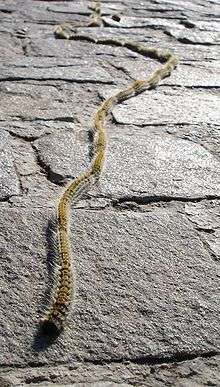Thaumetopoea
Thaumetopoea is a genus of moths belonging to the family Notodontidae. It was first described by Jacob Hübner in 1820.
| Thaumetopoea | |
|---|---|
 | |
| A Thaumetopoea species, pine processionary caterpillars | |
| Scientific classification | |
| Kingdom: | Animalia |
| Phylum: | Arthropoda |
| Class: | Insecta |
| Order: | Lepidoptera |
| Superfamily: | Noctuoidea |
| Family: | Notodontidae |
| Genus: | Thaumetopoea Hübner, 1820 |
| Synonyms | |
| |
In their caterpillar form, they bear the vernacular name of processionary because these gregarious larvae move in a single file. In their imago (adult moth) form, members of this genus live a few days without feeding.
Some Thaumetopoea species, for example Thaumetopoea pityocampa, are lepidopteran defoliators experiencing an expansion range towards higher latitudes and altitudes due to the current climate warming.[1] Moreover, processionary caterpillars carry urticating setae, which cause health problems in humans.[2]
Systematics
The etymology of the genus name derives from the two ancient Ancient Greek words θαυματόεις (thaumatóeis), "marvelous", and ποιέω (poiéō), "to do", and literally means "showing beautiful things".[3][4] This explains why the name is sometimes spelled Thaumatopoea,[5] incorrectly from the taxonomic standpoint, but in accordance with its etymology.
The genus Thaumetopoea contains the following species:
- Thaumetopoea bonjeani (Powell, 1922) - cedar processionary
- Thaumetopoea herculeana Rambur, 1840
- Thaumetopoea pinivora (Treitschke, 1834) or Traumatocampa pinivora (Treitschke 1834) - eastern pine processionary
- Thaumetopoea pityocampa (Denis and Schiffermüller, 1775) or Traumatocampa pityocampa (Denis & Schiffermüller 1775) - pine processionary
- Thaumetopoea processionea (Linnaeus, 1758) - oak processionary
- Thaumetopoea solitaria (Freyer, 1838) - pistachio processionary or solitary
- Thaumetopoea wilkinsoni Tams, 1924 or Traumatocampa wilkinsoni (Tams 1926)
- Thaumetopoea hellenica
- Thaumetopoea mediterranea
_(4990106967).jpg)
References
- Gschloessl, Bernhard; Vogel, Heiko; Burban, Christian; Heckel, David; Streiff, Réjane; Kerdelhué, Carole (2014). "Comparative analysis of two phenologically divergent populations of the pine processionary moth (Thaumetopoea pityocampa) by de novo transcriptome sequencing". Insect Biochemistry and Molecular Biology. 46: 31–42. doi:10.1016/j.ibmb.2014.01.005. PMID 24468684.
- Battisti, Andrea; Larsson, Stig; Roques, Alain (31 January 2017). "Processionary Moths and Associated Urtication Risk: Global Change–Driven Effect s". Annual Review of Entomology. 62 (1): 323–342. doi:10.1146/annurev-ento-031616-034918. ISSN 0066-4170. PMID 27860523.
- Bailly, Anatole (1 January 1981). Abrégé du dictionnaire grec français. Paris: Hachette. ISBN 2010035283. OCLC 461974285.
- Bailly, Anatole. "Greek-French dictionary online". www.tabularium.be. Retrieved 30 October 2017.
- Quicke, Donald L. J. (22 December 2014). The Braconid and Ichneumonid Parasitoid Wasps: Biology, Systematics, Evolution and Ecology. John Wiley & Sons. p. 515. ISBN 9781118907054.